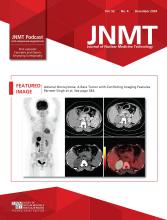Sara Johnson, EdD, CNMT, ARRT(N)(CT), NMTCB(RS), FSNMMI-TS
I am honored to introduce you to this JNMT issue, which underscores the importance of clinical instructors and takes a significant step in supporting their role. Enclosed in this issue are the definitions and tasks of clinical instructors and academic affiliate supervisors, also known as clinical supervisors. You will also find a copy of the Clinical Instructor Manual, created by the SNMMI-TS Educators Committee. This manual is a versatile resource that provides support and education to those working with clinical students. It delineates the roles and responsibilities of those involved in clinical education and provides clinical staff with training on educational theories, communication, and assessment skills. The manual is intended to be used by clinical affiliates to facilitate the orientation and training of clinical instructors, with the flexibility to incorporate program-specific resources and policies. Lastly, this clinical instructor manual can also serve as an educational guide for nuclear medicine departments that do not train students but need to develop or enhance technologist competency as departments onboard new staff or implement new protocols and technologies into the department.
Several factors in recent years have made nuclear medicine technology education a “hot” topic, pun intended. For example, the addition of new radiopharmaceuticals and the onset of hybrid, digital, and advanced imaging systems have expanded the amount of information educators must include. Still, challenges in higher education mean they must fit more information into less time, often while facing budget cuts. Additionally, there has been much discussion in recent years about the workforce pipeline for nuclear medicine technologists (1). As the number of retirees increases each year and the number of graduates and schools decreases, there is a concern for educational programs’ ability to adequately support the workforce (2). On the other hand, nuclear medicine technology education is evolving as several programs are expanding into online and distance education, allowing them to reach underserved areas of the country. Furthermore, key stakeholders demand that programs can demonstrate competency in all areas of nuclear medicine by the time a student graduates, essentially meaning more is expected with less time and resources to support it.
Despite these complex issues, clinical instructors are the unsung heroes of nuclear medicine technology education. The success of nuclear medicine technology education and student competency development relies heavily on clinical instructors. Although educational programs prepare students to enter the clinic by ensuring they understand the science of nuclear medicine, providing the development of basic skills, and supporting the development of mastery to competency, the clinical setting is where competency development truly occurs. Clinical instructors play a vital role in the process as students spend far more time in the clinical setting working side-by-side with clinical staff. Interactions with clinical instructors have a huge impact on a student’s ability to develop competency (3).
Research underpins the importance of the student–instructor relationship, proper training of clinical instructors, and the important factor that role modeling plays in student learning. The relationship students have with clinical instructors, including the clinical supervisor, is vital to students’ achievement of competency (3,4). Clinical instructor attitudes and behaviors can empower students, leading to higher confidence and competence, or hinder their learning and undermine their self-efficacy (4). Clinical staff who do not demonstrate ideal role modeling, technical skills, interprofessional skills, or a desire to teach students will negatively impact student motivation and the development of technical and interprofessional skills in the student (3). Research has demonstrated the important role that clinical instructors play in a student’s development of competency, motivation, and sense of self-efficacy. Knight noted that the relationship between a clinical instructor and a student may be the single most important factor in student success (3). Clinical staff performing evaluations also greatly impact the assessment of competency and may degrade the reliability and validity of assessment tools (3).
Therefore, it is essential that clinical instructors are adequately prepared for and supported in their role. Proper training and orientation are important to all clinical supervisors, including clearly defining the role, expectations, policies, and procedures of clinical instruction (3,5). Clinical instructors must be orientated effectively to their role and the expectations of the student, school, and clinical affiliate. Baird et al. maintained the importance of training clinical instructors not only for the policies and procedures of the program but also for the role clinical instructors play in the development of a student’s values, attitudes, and competency (4).
The resources provided in this issue of JNMT hold the potential to advance education in our field and improve the overall competency of new graduates and nuclear medicine technologists. Achievement of clinical competency is paramount to student success in nuclear medicine technology programs (6,7). Technologist competency is closely tied to quality in nuclear medicine, making it even more important that students enter the workforce with competency (8). The clinical instructor manual provides support and education to those training current and future nuclear medicine technologists. The manual is based on research in nuclear medicine and other health care education research to address the important components of effective clinical instruction. The manual is intended to be used by clinical affiliates to assist in orientation and training of clinical instructors. The manual allows for the addition of program-specific resources and policies. I encourage clinical affiliates to add a copy of the manual to their department and add program-specific policies, clinical syllabi, program-specific assessments, and advisory board information. Supporting clinical instructors ultimately supports the overall competency and advancement of the field of nuclear medicine technology.
REFERENCES
- Received for publication September 16, 2024.
- Accepted for publication September 16, 2024.








